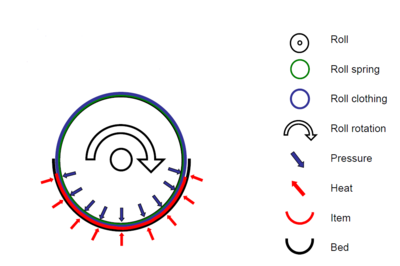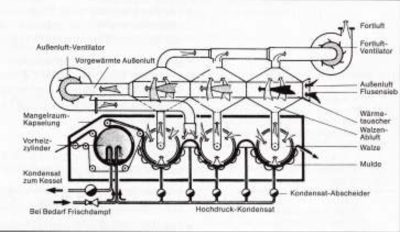Difference between revisions of "Ironing/calendering of clothes"
From Efficiency Finder
m (→Flatwork Ironing) |
|||
| (3 intermediate revisions by one other user not shown) | |||
| Line 1: | Line 1: | ||
| + | Back to [[Subsection DB textiles|EFFICIENCY FINDER OF TEXTILE INDUSTRY]] | ||
| + | |||
== Flatwork Ironing == | == Flatwork Ironing == | ||
| Line 15: | Line 17: | ||
* heating of air 17 % | * heating of air 17 % | ||
* heat losses 37 % | * heat losses 37 % | ||
| + | |||
== Energy efficiency measures == | == Energy efficiency measures == | ||
| Line 22: | Line 25: | ||
The machine is covered and a heat exchanger for the offgas of the roll is installed. | The machine is covered and a heat exchanger for the offgas of the roll is installed. | ||
| − | [[File:ironing_htex.png | | + | [[File:ironing_htex.png | 400 px]] |
''' Other measures ''' | ''' Other measures ''' | ||
| Line 30: | Line 33: | ||
* Controlling of cylinder press temperature | * Controlling of cylinder press temperature | ||
* Adoption of contact pressure/ thickness of textile layer | * Adoption of contact pressure/ thickness of textile layer | ||
| + | |||
| + | |||
| + | == Source == | ||
| + | |||
| + | Leonardo da Vinci project [http://www.laundry-sustainability.eu Laundry Sustainability] | ||
| + | |||
| + | |||
| + | Back to [[Subsection DB textiles|EFFICIENCY FINDER OF TEXTILE INDUSTRY]] | ||
Latest revision as of 13:03, 23 August 2017
Back to EFFICIENCY FINDER OF TEXTILE INDUSTRY
Flatwork Ironing
Principle of the ironing process:
Heat balance
- textile heating 4 %
- heating of water 5 %
- vaporization of water 40 %
- heating of air 17 %
- heat losses 37 %
Energy efficiency measures
Heat recovery
The machine is covered and a heat exchanger for the offgas of the roll is installed.
Other measures
- Adoption of velocity of the machine
- Controlling of residual textile moisture
- Controlling of cylinder press temperature
- Adoption of contact pressure/ thickness of textile layer
Source
Leonardo da Vinci project Laundry Sustainability

